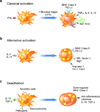Control of macrophage activation and function by PPARs
- PMID: 20508200
- PMCID: PMC2897247
- DOI: 10.1161/CIRCRESAHA.110.216523
Control of macrophage activation and function by PPARs
Abstract
Abstract: Macrophages, a key component of the innate defense against pathogens, participate in the initiation and resolution of inflammation, and in the maintenance of tissues. These diverse and at times antithetical functions of macrophages are executed via distinct activation states, ranging from classical to alternative to deactivation. Because the dysregulation of macrophage activation is pathogenically linked to various metabolic, inflammatory and immune disorders, regulatory proteins controlling macrophage activation have emerged as important new therapeutic targets. Here, the mechanisms by which peroxisome proliferator-activated receptors (PPARs) transcriptionally regulate macrophage activation in health and disease states, including obesity, insulin resistance and cardiovascular disease, are reviewed.
Figures





References
-
- Kersten S, Desvergne B, Wahli W. Roles of PPARs in health and disease. Nature. 2000;405:421–424. - PubMed
-
- Evans RM, Barish GD, Wang Y-X. PPARs and the complex journey to obesity. Nat Med. 2004;10:355–361. - PubMed
-
- Issemann I, Green S. Activation of a member of the steroid hormone receptor superfamily by peroxisome proliferators. Nature. 1990;347:645–650. - PubMed
-
- Dreyer C, Keller H, Mahfoudi A, Laudet V, Krey G, Wahli W. Positive regulation of the peroxisomal beta-oxidation pathway by fatty acids through activation of peroxisome proliferator-activated receptors (PPAR) Biol Cell. 1993;77:67–76. - PubMed
Publication types
MeSH terms
Substances
Grants and funding
LinkOut - more resources
Full Text Sources
Other Literature Sources

